高中英语it的用法课件
- 格式:ppt
- 大小:2.69 MB
- 文档页数:58
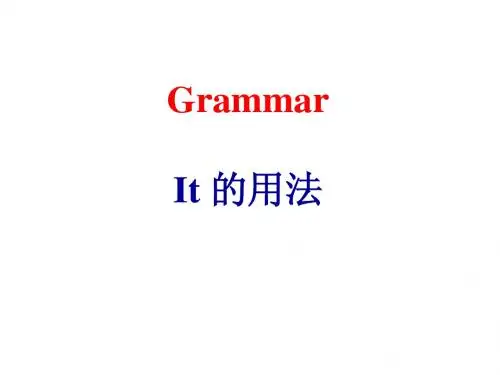
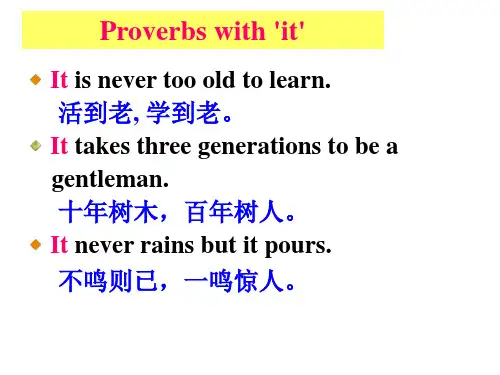
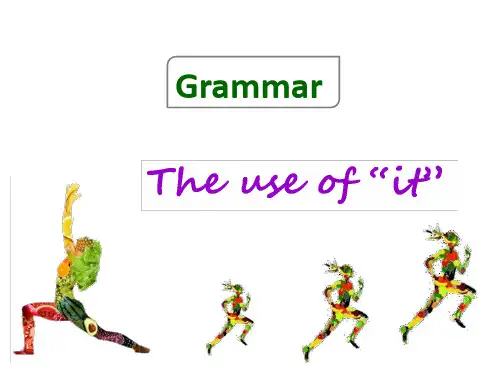

It的用法It的用法在高考中也是重现率较高的语言点,尤其是it用于强调句。
其考查方式多通过“单项填空”进行,偶尔也出现在“短文改错”和“完形填空”中。
一、要点点拔1.代替上文中提到过的人或事物。
指代人时,一般用于小孩或身份不十分明朗的人。
1) -Who is the baby?-It‘s my teacher’s son.2) -Who is that gentleman?-It's my friend Tom.He(不可用It) wants to see you.2.用于表达天气、环境、时间、距离、季节等。
例如:1) It’s half an hour’s walk from here to our school.2) It‘s nice and warm here.3) But it's two o'clock now, and it's time for us to go to school.3.用作形式主语.it 没有具体意义,而只是帮助把真正的主语移至句子后尾,使句子显得平稳一些,能借it 给移至句子后尾的主语有三种:一种由不定式表示,一种由动名词表示,一种由从句表示。
1).It 替代真正的主语——动词不定式短语.It is easier to say than to do .It is a good act to help the others.2).it 替代真正的主语——动名词短语,以动名词短语做主语的句子,主要在以no good, no use, no harm, dangerous, foolish 等词作表语的句中.It’s no harm drinking running water in that area。
It’s foolish talking like that.3).it 替代从句作主语,用从句做主语的带it 的句子很多,常见的有下面几类:①It is a pity (a shame ,a fact ,a wonder ,a good thing, etc. ) that…It is a shame that he didn’t pass the exam.②It is strange ( surprising, obvious ,true, good, possible, clear, etc. ) that…。
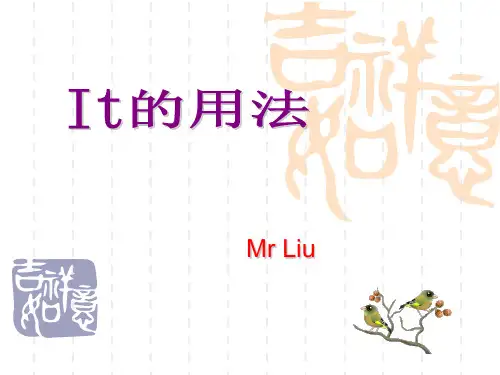
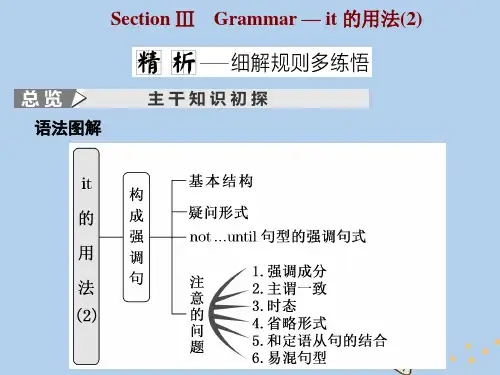
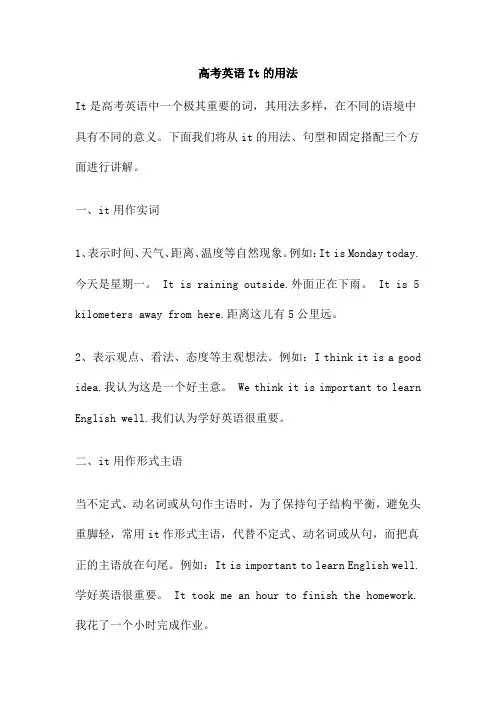
高考英语It的用法It是高考英语中一个极其重要的词,其用法多样,在不同的语境中具有不同的意义。
下面我们将从it的用法、句型和固定搭配三个方面进行讲解。
一、it用作实词1、表示时间、天气、距离、温度等自然现象。
例如:It is Monday today.今天是星期一。
It is raining outside.外面正在下雨。
It is 5 kilometers away from here.距离这儿有5公里远。
2、表示观点、看法、态度等主观想法。
例如:I think it is a good idea.我认为这是一个好主意。
We think it is important to learn English well.我们认为学好英语很重要。
二、it用作形式主语当不定式、动名词或从句作主语时,为了保持句子结构平衡,避免头重脚轻,常用it作形式主语,代替不定式、动名词或从句,而把真正的主语放在句尾。
例如:It is important to learn English well.学好英语很重要。
It took me an hour to finish the homework.我花了一个小时完成作业。
三、it用作形式宾语当不定式、动名词或从句作宾语时,为了保持句子结构平衡,避免头重脚轻,常用it作形式宾语,代替不定式、动名词或从句,而把真正的宾语放在句尾。
例如:I think it is important to learn English well.我认为学好英语很重要。
He found it hard to learn English well.他发现学好英语很难。
四、it用于强调句型中强调句型是英语中一个重要的句型,用于突出强调某个成分,特别是主语、宾语和状语等。
在强调句型中,it没有实际意义,只是起到引导作用。
例如:It is I who am the best student in my class.我是班里最好的学生。
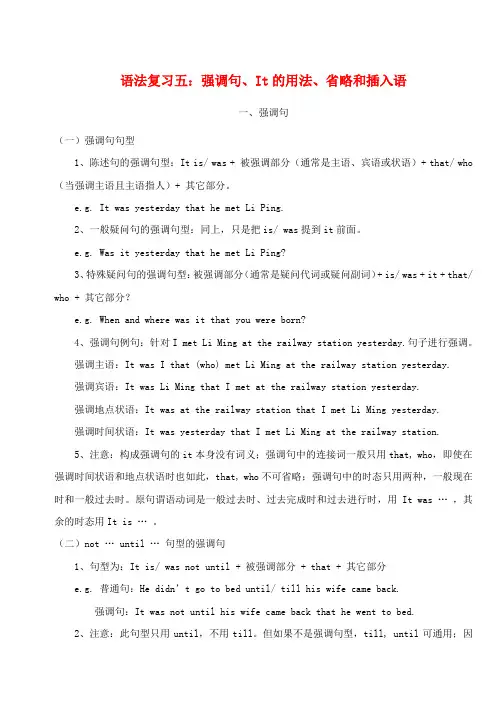
语法复习五:强调句、It的用法、省略和插入语一、强调句(一)强调句句型1、陈述句的强调句型:It is/ was + 被强调部分(通常是主语、宾语或状语)+ that/ who (当强调主语且主语指人)+ 其它部分。
e.g. It was yesterday that he met Li Ping.2、一般疑问句的强调句型:同上,只是把is/ was提到it前面。
e.g. Was it yesterday that he met Li Ping?3、特殊疑问句的强调句型:被强调部分(通常是疑问代词或疑问副词)+ is/ was + it + that/ who + 其它部分?e.g. When and where was it that you were born?4、强调句例句:针对I met Li Ming at the railway station yesterday.句子进行强调。
强调主语:It was I that (who) met Li Ming at the railway station yesterday.强调宾语:It was Li Ming that I met at the railway station yesterday.强调地点状语:It was at the railway station that I met Li Ming yesterday.强调时间状语:It was yesterday that I met Li Ming at the railway station.5、注意:构成强调句的it本身没有词义;强调句中的连接词一般只用that, who,即使在强调时间状语和地点状语时也如此,that, who不可省略;强调句中的时态只用两种,一般现在时和一般过去时。
原句谓语动词是一般过去时、过去完成时和过去进行时,用It was … ,其余的时态用It is … 。
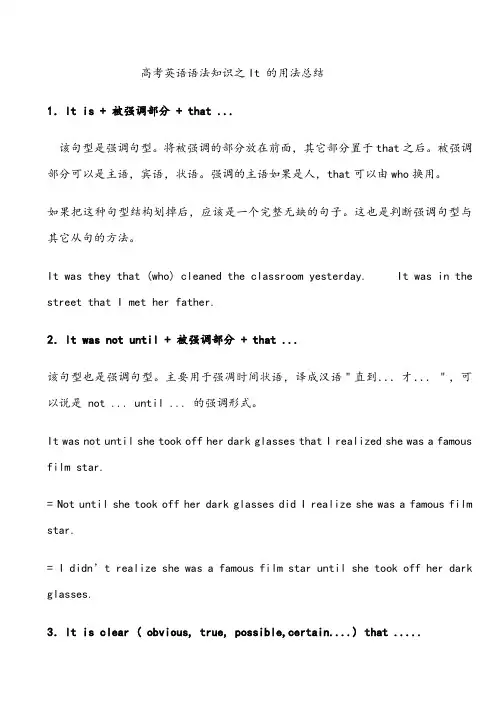
高考英语语法知识之It 的用法总结1.It is + 被强调部分 + that ...该句型是强调句型。
将被强调的部分放在前面,其它部分置于that之后。
被强调部分可以是主语,宾语,状语。
强调的主语如果是人,that可以由who换用。
如果把这种句型结构划掉后,应该是一个完整无缺的句子。
这也是判断强调句型与其它从句的方法。
It was they that (who) cleaned the classroom yesterday. It was in the street that I met her father.2.It was not until + 被强调部分 + that ...该句型也是强调句型。
主要用于强凋时间状语,译成汉语"直到...才...",可以说是 not ... until ... 的强调形式。
It was not until she took off her dark glasses that I realized she was a famous film star.= Not until she took off her dark glasses did I realize she was a famous film star.= I didn’t realize she was a famous film star until she took off her dark glasses.3.It is clear ( obvious, true, possible,certain....) that .....该句型中it 是形式主语,真正的主语是that 引导的主语从句,常译为"清楚(显然,真的,肯定...)"是主语从句最常见的一种结构。
It is very clear that he’s round and tall like a tree.= That he’s round and tall like a tree is very clear.4. It is important ( necessary, right, strange, natural...) that ...由于主句中的形容词不同,that 后的从句中要用虚拟语气(should + 动词原形),should 可以省去。
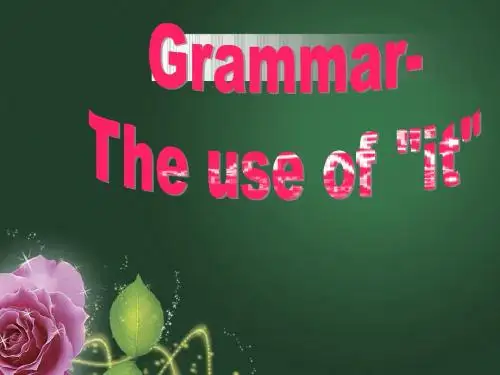
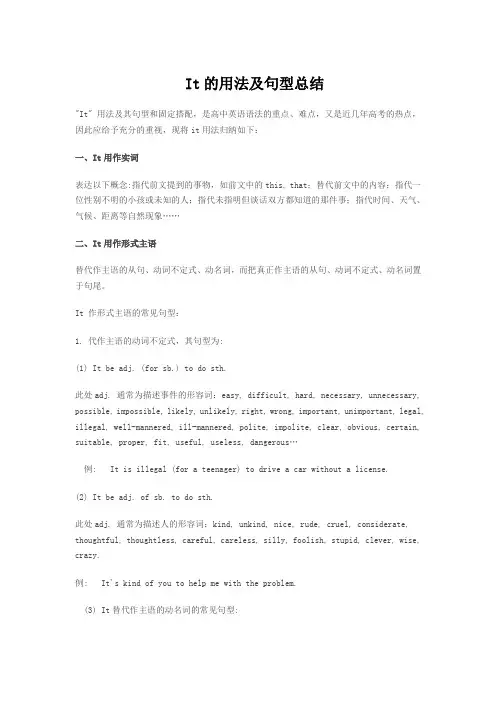
It的用法及句型总结"It" 用法及其句型和固定搭配,是高中英语语法的重点、难点,又是近几年高考的热点,因此应给予充分的重视,现将it用法归纳如下:一、It用作实词表达以下概念:指代前文提到的事物,如前文中的this, that;替代前文中的内容;指代一位性别不明的小孩或未知的人;指代未指明但谈话双方都知道的那件事;指代时间、天气、气候、距离等自然现象……二、It用作形式主语替代作主语的从句、动词不定式、动名词,而把真正作主语的从句、动词不定式、动名词置于句尾。
It 作形式主语的常见句型:1. 代作主语的动词不定式,其句型为:(1) It be adj. (for sb.) to do sth.此处adj. 通常为描述事件的形容词:easy, difficult, hard, necessary, unnecessary, possible, impossible, likely, unlikely, right, wrong, important, unimportant, legal, illegal, well-mannered, ill-mannered, polite, impolite, clear, obvious, certain, suitable, proper, fit, useful, useless, dangerous…例: It is illegal (for a teenager) to drive a car without a license.(2) It be adj. of sb. to do sth.此处adj. 通常为描述人的形容词:kind, unkind, nice, rude, cruel, considerate, thoughtful, thoughtless, careful, careless, silly, foolish, stupid, clever, wise, crazy.例: It's kind of you to help me with the problem.(3) It替代作主语的动名词的常见句型:It's no good/use doing…It's (well)worth doing…It's (well)worth on e's while doing/to do…It's (well)worth while doing/ to do例: It's no use crying over spilt milk(覆水难收).2. It替代作主语的从句常见句型:(1) It is + noun +从句例: It is no secret that the president wants to have a second term at office.(2) It is adj. +clauseIt's surprising that… (should)………竟然……It's a pity/shame that…(should)………竟然……例: It's important that you should apologize to her for your rudeness.(=It's of much importance that you should apologize to her for your rudeness.)(3) It verb sb. + clause= It is v-ing + clauseIt+surprise/delight/interest/disappoint/worry/disturb/annoy/amaze /bother/conc ern/frighten/please/anger sb. that…例: It worried me that she drove so fast.(= It was worrying that she drove so fast.)(4) It verb (to sb.) that…= sb/sth verb to do例: It (so) happened/chanced that they were out.(= They happened/chanced to be out.)(5) It is v-ed that…=sb/sth is to do(verb=say, report, think, believe, hope, expect, agree, accept, decide, determine, intend, plan, understand, know)例: It is said that the couple have gotten divorced.(=The couple are said to have gotten divorced.)(6) It is v-ed that … (should)…(verb=demand, request, require, order, suggest, advise, recommend例 It is suggested that they should begin with the third question.三、It作主语的句型1. It takes sb. … to do…(=sb takes…to do…)某人用多长时间做某事例: It took the men a week to mend our roof.(= The men took a week to mend our roof.)2. It's (just)(un)like sb. to do…(不)像某人做某事的风格例: It was (just) like him to think of helping us.3. It's (about/high) time that… should /v-ed…是该做某事的时候了例: It's(about/high) time that we should take action.4. It's the x-th time (that) … have v-ed…第几次做某事了例: It's the third time that he has failed the driving test.5. It is/has been… since …continuous v-ed(延续性动词) 某动作持续了多长时间例: It's 10 years since he lived here6. It was(not)… before…过(不)了多长时间某动作发生了例: It was not long before they arrived.四、It 作形式宾语用来替代作宾语的从句、动词不定式、动名词,而把真正作宾语的从句、动词不定式、动名词置于句尾。
“It"用法及其句型和固定搭配讲解“It”用法及其句型和固定搭配,是高中英语语法的重点、难点,又是近几年高考的热点,因此应给予充分的重视,现将it用法归纳如下:一、It用作实词表达以下概念:指代前文提到的事物,前文中的this,that;替代前文中的内容;指代一位性别不明的小孩或未知的人;指代未指明但谈话双方都知道的那件事;指代时间、天气、气候、距离等自然现象……二、It用作形式主语替代作主语的从句、动词不定式、动名词,而把真正作主语的从句、动词不定式、动名词置于句尾.It 作形式主语的常见句型:1. 代作主语的动词不定式,其句型为(1)It be adj.(for sb。
)to do sth。
此处adj。
通常为描述事件的形容词:easy,difficult,hard,necessary,unnecessary,possible,impossible,likely,unlikely,right,wrong,important,unimportant,legal,illegal,well —mannered,ill-mannered,polite,impolite,clear,obvious,certain,suitable,proper,fit,useful,useless,dangerous…例It is illegal(for a teenager)to drive a car without a license.(2)It be adj。
of sb. to do sth。
此处adj. 通常为描述人的形容词:kind,unkind,nice,rude,cruel,considerate,thoughtful,thoughtless,careful,careless,silly,foolish,stupid,clever,wise,crazy.例It’s kind of you to help me with the problem。
代词和it的用法一、代词1.人称代词They like him.[名师指津]在非正式英语尤其是口语中,人称代词作表语时常可用其宾格形式代替主格。
在比较状语从句中,有时也可用宾格代替主格(尤其是其后跟有同位语“all”时)。
—Who is it?—It’s me.He is taller than I (或me).He is taller than us all.若可能引起误解,就不能用宾格代替主格。
试比较:He loves you more than I.(他比我更爱你。
)He loves you more than me.(他爱你比爱我更多。
)2.物主代词(1)his pen, our books。
(2)“形容词性物主代词+own”常用来强调“某人自己的”,其后可跟名词。
Don’t use my pen.Why not use your own (pen)?I want a car of my own.(3)“of+名词性物主代词(或名词所有格)”构成双重所有格形式。
如:a friend of mine。
3.反身代词反身代词myself, yourself, himself, herself, itself, oneself, ourselves, yourselves, themselves可在句中作表语、宾语和同位语。
I am not quite myself today.(表语)He saw himself in the mirror.(宾语)I myself did it.(同位语)4.相互代词(1)相互代词each other和one another表示相互关系,两者差别不大,一般用作宾语。
Bill and Helen blamed each other.(2)each other和one another有所有格形式,可用作定语。
They looked into each other’s eyes for a silent moment.5.指示代词指示代词有this, that, these, those, it, such, same等。
It句型背诵一.It 做形式主语●to do 做真正的主语1. 我很方便和他取得联系。
It is convenient for me to get in touch with him.2. 你那样做是很愚蠢的。
It is stupid of you to do so.3. 我们听到那消息很惊讶。
It was amazing to us to hear the news4. 修长城花费了成千上万人很多年的时间。
It took thousands of people many years to build the Greatwall.●doing做真正主语5. 你和他理论是没有用的。
It is no use your arguing with him.6. 覆水难收It is no good crying over spilt milk.7. 雨天爬山真是有趣。
It is great fun climbing mountains on raining days.8这项工作值得做It is worthwhile doing the work.It is worthwhile to do the work.●that 做真正主语9. 他整天责备别人是不足为奇。
It is no wonder that he scolds others all day long.10. 据信他在国外学习/ 要去国外学习/ 去了国外学习。
It is believed that he is studying abroad / to go abroad for study/ has gone abroad for study. He is believed to be studying abroad/ to go abroad for study/ to have gone abroad for study.11. 我突然想起我忘了锁门。
高中英语语法权威解析目录:第01章名词性从句第02章“It”用法及其句型和固定搭配讲解第03章高中英语语法中的省略现象第04章主谓一致第05章动词不定式第06章倒装结构第07章定语从句第08章被动语态第09章祈使句第10章感叹句第11章疑问句第12章名词第一章名词性从句在句子中起名词作用的句子叫名词性从句(Noun Clauses)。
名词性从句的功能相当于名词词组, 它在复合句中能担任主语、宾语、表语、同位语、介词宾语等,因此根据它在句中不同的语法功能,名词从句又可分别称为主语从句、宾语从句、表语从句和同位语从句。
一.主语从句主语从句是在复合句中充当主语的从句,通常放在主句谓语动词之前或由形式主语it代替,而本身放在句子末尾。
1. It 作形式主语和it引导强调句的比较It 作形式主语代替主语从句,主要是为了平衡句子结构,主语从句的连接词没有变化。
而it引导的强调句则是对句子某一部分进行强调,无论强调的是什么成分,都可用连词that。
被强调部分指人时也可用who/whom。
例如:a) It is a pity that you didn‟t go to see the film. 你不去看那场电影真可惜。
b) It doesn‟t interest me whether you succeed or not.我对你成功与否不感兴趣。
c) It is in the morning that the murder took place.谋杀案是在早上发生的。
(强调句型)d) It is John that broke the window.是John打碎的窗户。
(强调句型)2. 用it 作形式主语的结构(1) It is +名词+从句It is a fact that … 事实是…It is an honor that …非常荣幸It is common knowledge that …是常识(2) It is +形容词+从句It is natural that… 很自然…It is strange that… 奇怪的是…(3) It is +不及物动词+从句It seems that… 似乎…It happened that… 碰巧…It appears that… 似乎…(4) It +过去分词+从句It is reported that… 据报道…It has been proved that… 已证实…It is said that… 据说…3. 主语从句不可位于句首的五种情况:(1)if 引导的主语从句不可居于复合句句首。